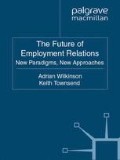Abstract
Employee engagement is a topic that has evolved considerably. As it has increased in popularity, the quest to define what it is has continued. For example, Storey, Ulrich, Welbourne & Wright (2009), in their chapter on employee engagement, discuss the various groups that provide definitions of the topic. They start out talking about the definitions proposed by various corporations (e.g. Caterpillar, Dell), then move to the approaches used by consulting firms (e.g. Corporate Leadership Council, Gallup), and next suggest a few definitions provided by academics (e.g. Kahn, 1990; Shaw, 2005). The conclusion, reached by many other authors working in the area, is that engagement describes a process or a set of outcomes versus a clear and agreed upon construct.
Access this chapter
Tax calculation will be finalised at checkout
Purchases are for personal use only
Preview
Unable to display preview. Download preview PDF.
6 Engaged in What? So What? A Role-Based Perspective for the Future of Employee Engagement
Carmeli, A., Ben-Hador, B,, Waldman, D. A., & Rupp, D. E. (2009). How leaders cultivate social capital and nurture employee vigor: implications for job performance. Journal of Applied Psychology, 94(6), 1553–1561.
Conference Board, The. (2010). Senior corporate communications management conference. November 3–5, 2010. Davidson Conference Center on the Campus of USC, Los Angeles, CA.
Ferrer, J. (2005). Employee engagement: is it organizational commitment renamed? (Victoria University, School of Management, Working Paper Series). Melbourne: Victoria University.
Frauenheim, E. (2009). ‘A skeptical view of engagement’. Workforce Management Online December.
Gibbons, J. M. (2006). Employee engagement: a review of current research and its implications. (Conference Board Report Number: E-0010–06-RR). New York: The Conference Board.
Harter, J. K., Schmidt, F. L., & Hayes, T. A. (2002). Business-unit-level relationship between employee satisfaction, employee engagement, and business outcomes: a meta-analysis. Journal of Applied Psychology, 87(2), 268–279.
Kahn, W. A. (1990). Psychological conditions of personal engagement and disengagement at work. Academy of Management Journal, 33(4), 692–724.
Kroll, K. (2005, September 15). No employee left behind. Forbes Online. Retrieved December 15, 2010, from http://www.forbes.com/forbes/2005/1003/060.html
Kular, S., Gatenby, M., Rees, C., Soane, E., & Truss, K. (2008). Employee engagement: a literature review. Kingston Hill: Kingston University.
Loehr, J. & Schwartz, T. (2003). The power of full engagement: managing energy, not time, is the key to high performance and personal renewal, New York: The Free Press.
Macey, W. H., & Schneider, B. (2008). The meaning of employee engagement. Industrial and Organizational Psychology, 1(1), 3–30.
Macey, W. H., Schneider, B., Barbera, K. M., & Young, S. A. (2009). Employee engagement: tools for analysis, practice, and competitive advantage. Rolling Meadows, IL: Wiley-Blackwell.
MacLeod, D., & Clarke, N. (2010). Engaging for success: enhancing performance through employee engagement. Surrey: Department for Business Innovation and Skills.
Newman, D. A., & Harrison, D. A. (2008). Been there, bottled that: are state and behavioral work engagement new and useful construct ‘wines’? Industrial and Organizational Psychology, 1(1), 31–35.
Pryce-Jones, J. (2010, June 11). Protect your energy at work. Psychology Today. Retrieved from http://www.psychologytoday.com/blog/happiness-work/201006/protect-your-energy-work
Rich, B. L., Lepine, J. A., & Crawford, E. R. (2010). Job engagement: antecedents and effects on job performance. Academy of Management Journal, 53(3), 617–635.
Robertson-Smith, G., & Markwick, C. (2009) Employee engagement: a review of current thinking. (IES White Paper). Brighton, UK: Institute for Employment Studies.
Saks, A. M. (2006). Antecedents and consequences of employee engagement. Journal of Managerial Psychology, 21(7), 600–619.
Shaw, K. (2005). Employee engagement: how to build a high performance workforce, Chicago: Melcrum Publishing Limite.
Sonnentag, S. (2003). Recovery, work engagement, and procactive behavior: a new look at the interface between nonwork and work. Journal of Applied Psychology, 88(3), 518–528.
Storey, J., Ulrich, D., Welbourne, T. M., & Wright, P. M. (2009). Employee engagement. In J. Storey, P. Wright, & D. Ulrich (eds) The Routledge Companion to Strategic Human Resource Management (pp. 299–315). New York: Routledge.
Welbourne, T. M., Johnson, D., & Erez, A. (1998). The role-based performance scale: validity analysis of a theory-based measure. Academy of Management Journal, 41(1), 50–55.
Editor information
Editors and Affiliations
Copyright information
© 2011 Theresa M. Welbourne
About this chapter
Cite this chapter
Welbourne, T.M. (2011). Engaged in What? So What? A Role-Based Perspective for the Future of Employee Engagement. In: Wilkinson, A., Townsend, K. (eds) The Future of Employment Relations. Palgrave Macmillan, London. https://doi.org/10.1057/9780230349421_6
Download citation
DOI: https://doi.org/10.1057/9780230349421_6
Publisher Name: Palgrave Macmillan, London
Print ISBN: 978-1-349-31665-6
Online ISBN: 978-0-230-34942-1
eBook Packages: Palgrave Business & Management CollectionBusiness and Management (R0)

